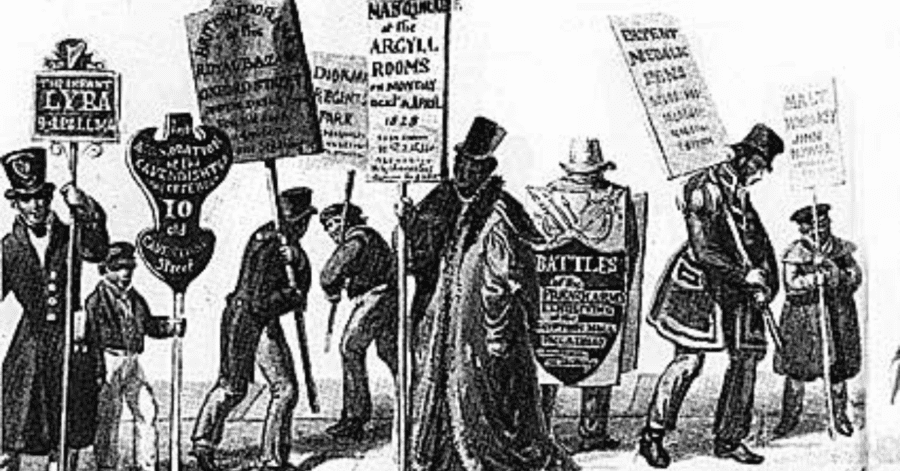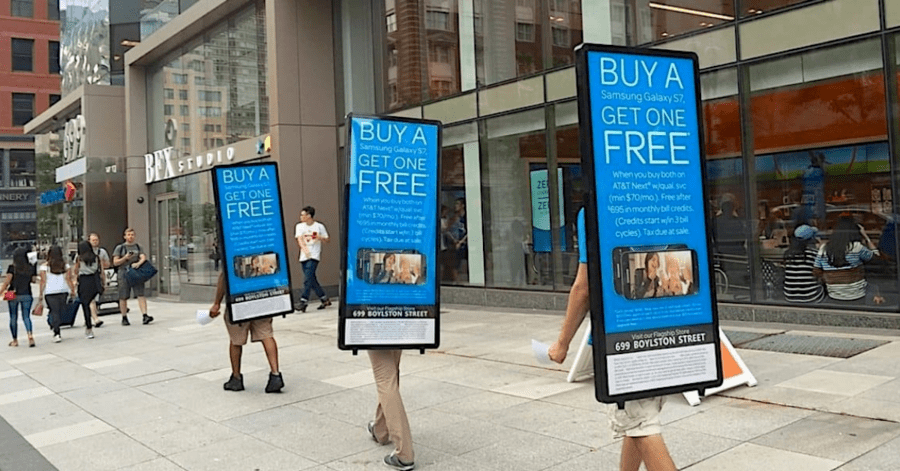
When researching your options for outdoor marketing, walking advertisements are likely the last thing you’ll think about. However, we all know one when we see one. They’re usually standing on the corner of a sidewalk, flipping a sign and alerting you of the cars they have for sale. Or maybe you’ve seen them just outside a small business, sporting bold letters that bring awareness to a promotion.
Basically, a walking advertisement describes an age-old form of street-level marketing. People will hold, wear, or do tricks with signs in public spaces to promote a brand.
While this marketing tactic has been around for a while, many may wonder if it is a profitable endeavor. Will this be a solid strategy for your business? Here, we’ll be exploring the ins and outs of walking advertisements.
A Brief History on The Walking Advertisement

Also known as the human billboard or the sign holder, the walking advertisement has been around for literal centuries. The first documented instance took place in 19th century London, when wall posters became subject to taxation. As the methods of advertising changed, there became a limit to the space on walls. This gave way to advertisers developing a new way to gain brand recognition.
Walking advertisements were created as a way to combat the competition and restriction of wall spaces. They were first introduced as simple signs toted on a stick, similar to the signs seen in modern protests. Over time, people began wearing these posters as sandwich boards. More wall poster restrictions paved the way for an increase in sign holding.
[in_content_ads gallery=”logos” logo=”on” title=”Need graphic design help?” subtitle=”Try Penji’s Unlimited Graphic Design and get all your branding, digital, print, and UXUI designs done in one place.” btntext=”Learn More” btnlink=”https://penji.co”]
Walking Advertisements In The Modern Age

Today, in the 21st century, there are many variations of walking advertisements. Let’s go over some of the old and new ones:
- Signs on a Stick: Nowadays, these signs are normally used for protests. But they can also be used as a unique form of advertisement.
- Handheld Signs: Very similar to the signs mentioned previously, though they are held by the hands instead of toted on a stick. They can be freely moved and flipped while in possession.
- Arrow Signs: A special type of handheld sign used to attract oncoming traffic
- T-Shirts, Hats, Apparel: Pretty self-explanatory. Walking around with company merch is a more subtle form of advertisement.
- Walking Balloons: A more experimental form of outdoor marketing. This is basically when people walk around with branded balloons. Often accompanied by other forms of advertisement.
- Strap-On Billboard: This is a modern walking ad in which a billboard is strapped onto any part of the body. Usually on the back.
- LED Walking Billboard: Yes, there are light-up ones too.
Modern walking ads will usually come in teams, complete with an enthusiastic composure and numerous sign tricks. Seriously, they have literal tricks. Many of these holders train themselves in the art of sign flipping.
There are many tactics that people pair with walking advertisements to get your attention. For instance, handing out free merchandise and samples. Many small restaurants will include a person standing outside. They’ll often have a plate of samples along with a sandwich board showcasing their specialty dishes.
Not only can walking advertisements target specific areas, but they can also move around quite easily if a location doesn’t suit them.
The Positives

So, what are the key benefits of modern walking advertisements? Probably the most advantageous feature is the price tag.
Technically speaking, a business can create a sign by simply gathering home supplies. For those who prefer something more polished, many professional designers can make your signs come to life. Compared to other forms of OOH advertising, the price is minuscule.
It is also worth noting that walking advertisements are environmentally friendly. Much like ads on bikes, they require absolutely nothing but manpower. No gas, toxins, or waste involved.
Finally, there are many ways to get creative with this marketing strategy. From light-up billboards to sign-waving tricks, walking advertisements are exactly what you make them.
The Negatives

Although they were quite successful in the 19th and 20th centuries, as time goes on, sign-holding has become less noticeable. This is because individuality draws people. They want to see something different and exciting.
Although sign twirling tends to draw lots of attention, it has been complained about in multiple cities. As you can probably guess, the tricks can be distracting to drivers, potentially causing accidents. Sign twirling is banned in many metropolitan areas.
Because they involve real human beings, walking advertisements are not ideal for harsh weather. Imagine lugging a huge billboard on your back in the middle of a windy storm. It’s impractical and doesn’t do your advertisement any justice.
So, Do Walking Advertisements Still Work?

The short answer is: yes, they do work… to an extent.
You won’t get as mant benefits as you would with other outdoor marketing strategies. However, the cheap price range may be its saving grace for your establishment.
We recommend walking advertisements to:
- Small businesses
- Local businesses
- Brands on a very small budget
- Charity/Activist organizations
There are many skills that you can pair with these ads to improve your reach. Aside from performing tricks, communication skills are the key to street-level marketing.
As for the signs themselves, elaborate, colorful, and bold designs work very well. Hiring someone to make them professionally is always an advantage. The more effort you put into your ad, the more likely you are to gain recognition.











